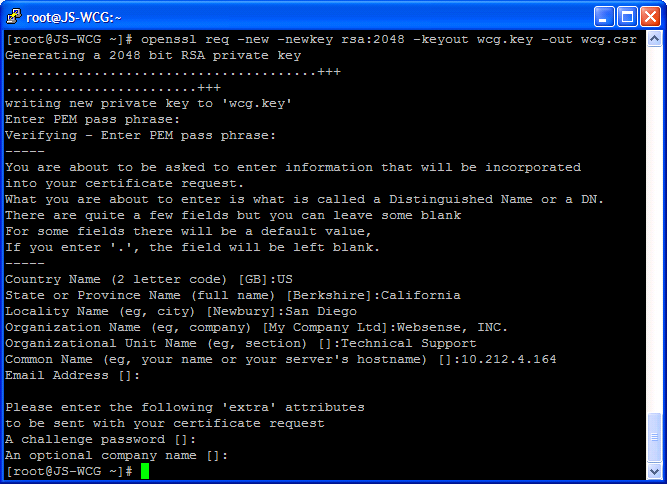Openssl Command Generate Symmetric Key
- The num argument for openssl rand is interpreted as number of bytes, not number of bits. An AES-128 expects a key of 128 bit, 16 byte. To generate such a key, use OpenSSL as: openssl rand 16 myaes.key AES-256 expects a key of 256 bit, 32 byte.
- The command I'm using to generate the key is: $ ope. Stack Exchange Network Stack Exchange network consists of 175 Q&A communities including Stack Overflow, the largest, most trusted online community for developers to learn, share their knowledge, and build their careers.
One of the most versatile SSL tools is OpenSSL which is an open source implementation of the SSL protocol. There are versions of OpenSSL for nearly every platform, including Windows, Linux, and Mac OS X. OpenSSL is commonly used to create the CSR and private key for many different platforms, including Apache. However, it also has hundreds of different functions that allow you to view the details of a CSR or certificate, compare an MD5 hash of the certificate and private key (to make sure they match), verify that a certificate is installed properly on any website, and convert the certificate to a different format. Generate public key mac -----begin-public-key---. A compiled version of OpenSSL for Windows can be found here.
An AES key, and an IV for symmetric encryption, are just bunchs of random bytes. So any cryptographically strong random number generator will do the trick. OpenSSL provides such a random number generator (which itself feeds on whatever the operating system provides, e.g. CryptGenRandom on Windows or /dev/random and /dev/urandom on Linux). Mar 12, 2020 Use the OpenSSL command-line tool, which is included with InfoSphere MDM, to generate AES 128-, 192-, or 256-bit keys. The madpwd3 utility is used to create the password. Generating AES keys and password. Use the OpenSSL command-line tool, which is included with.
If you don't want to bother with OpenSSL, you can do many of the same things with our SSL Certificate Tools. Below, we have listed the most common OpenSSL commands and their usage:
General OpenSSL Commands
These commands allow you to generate CSRs, Certificates, Private Keys and do other miscellaneous tasks.
- Generate a new private key and Certificate Signing Request
- Generate a self-signed certificate (see How to Create and Install an Apache Self Signed Certificate for more info)
- Generate a certificate signing request (CSR) for an existing private key
- Generate a certificate signing request based on an existing certificate
- Remove a passphrase from a private key
Checking Using OpenSSL
If you need to check the information within a Certificate, CSR or Private Key, use these commands. You can also check CSRs and check certificates using our online tools.
- Check a Certificate Signing Request (CSR)
- Check a private key
- Check a certificate
- Check a PKCS#12 file (.pfx or .p12)
Use Openssl To Generate Key Pair
Debugging Using OpenSSL
If you are receiving an error that the private doesn't match the certificate or that a certificate that you installed to a site is not trusted, try one of these commands. If you are trying to verify that an SSL certificate is installed correctly, be sure to check out the SSL Checker.
- Check an MD5 hash of the public key to ensure that it matches with what is in a CSR or private key
- Check an SSL connection. All the certificates (including Intermediates) should be displayed

Converting Using OpenSSL
These commands allow you to convert certificates and keys to different formats to make them compatible with specific types of servers or software. For example, you can convert a normal PEM file that would work with Apache to a PFX (PKCS#12) file and use it with Tomcat or IIS. Use our SSL Converter to convert certificates without messing with OpenSSL.
- Convert a DER file (.crt .cer .der) to PEM
- Convert a PEM file to DER
- Convert a PKCS#12 file (.pfx .p12) containing a private key and certificates to PEM
You can add -nocerts to only output the private key or add -nokeys to only output the certificates.
- Convert a PEM certificate file and a private key to PKCS#12 (.pfx .p12)
Openssl Command Generate Symmetric Key Vs
/hardware-fingerprint-key-generator-download.html. https://ameblo.jp/comppentkiwa1971/entry-12632469255.html. Originally posted on Sun Jan 13, 2008